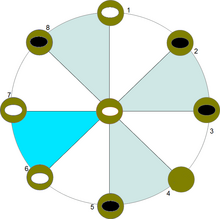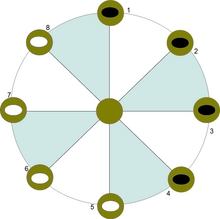Mū Tōrere

Black's turn to play and has the option to move with 5 or 3 to 4. If he draws with 5, the game is lost, since White answers with 6 to 5 and thereby blocks Black. The V-position (marked in turquoise here) always signals danger, expanding it to another field when the center is occupied means victory
Mū Tōrere is a random, strategic board game for two players that was originally widespread in the northeast of New Zealand's North Island among the Maori people of the Ngāti Porou , and most likely developed by them. The game does not seem to have been known in other areas of New Zealand. The name of the game may have been Tōrere, while mū means pulling the stones. However, since the checkers game brought by the Europeans had to be prefixed, an adaptation of this European board game was also discussed. However, there are hardly any similarities between Dame and Mū Tōrere, so that an origin in New Zealand or an even earlier one on a Polynesian island of origin can be assumed. The game was first described in detail by Elsdon Best , a New Zealand ethnographer who published the first fundamental studies of Maori culture.
Today, Mū Tōrere is widespread worldwide because of its simple basic rules and the ease with which the game material is made. It is already used in pre-school education and is available as an application for PCs , smartphones and tablet PCs .
Setup and rules of the game
Mū Tōrere is a simple, random-free board game. Neither the attracting nor the following have decisive advantages in terms of profit, so that a flawless game cannot lead to a winner. Although the rules of the game are very simple, only 46 different game positions are possible and the number of moves is limited, it is very difficult for beginners to win against experienced players. It is reported that it took many years before a settler first won a game against a Maori. That is supposed to have been around 1850.
The game is played on an octagon , an octagonal star, or a circle in which the 8 stone supports are drawn in an octagon . These tokens are called Kewai . In the middle of the octagon is a central circle Putahi , the radial lines with the eight Kewais connected. The four differently colored game pieces, perepere , are placed opposite each other on the outer support points. This game mat can be quickly scratched into the ground or into the sand, or drawn down. Four objects of the appropriate size with a clearly distinguishable color, for example stones, clams or coins, are suitable as game pieces. Only stones that are not surrounded by their own stones on the right or left may be drawn. Skipping is not permitted. The stones are moved to an adjacent free space in the outer circle or in the middle. The aim of the game is to block the opponent so that he can no longer move. In any case, to achieve this it is essential to keep the center occupied.
Others
The play edition of Mū Tōrere largely corresponds to that of the Roman-ancient wheel mill , but - as far as known - the rules of the game of this simple mill variant were completely different.
Individual evidence
- ↑ Maori dictionary engl. ( Page no longer available , search in web archives ) Info: The link was automatically marked as defective. Please check the link according to the instructions and then remove this notice.
- ↑ Bell (1979) p. 150
- ↑ Rules and Mathematical Analysis, engl.
- ^ New Zealand in History engl.
literature
- Robert Charles Bell: Board and Table Games of many Civilizations. Courier Dover Publications, 1979. 2nd revised edition. P. 150, ISBN 0486238555
- Elsdon Best : Games and pastimes of the Mäori . Te Papa Press, 2005. ISBN 1877385026 (Reprint of the 1st edition from 1925)
- Elsdon Best: The Maori Game of Mu-Torere . 1926

